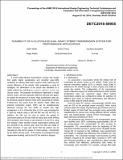Feasibility of a Clutchless Dual-Shaft Hybrid Transmission System for Performance Applications
Author(s)
Shah, Sahil Rajesh; Prost, Victor; Eubanks, Zachary; Reiter, Paige L.; Bondarchuk, Daria Alexandrovna; Hua, Yu; Dorsch, Daniel S.; Winter, Amos G.; ... Show more Show less
Downloadv003t01a035-detc2016-59955.pdf (2.401Mb)
PUBLISHER_POLICY
Publisher Policy
Article is made available in accordance with the publisher's policy and may be subject to US copyright law. Please refer to the publisher's site for terms of use.
Terms of use
Metadata
Show full item recordAbstract
A novel hybrid-electric transmission concept was sought that yields higher acceleration and smoother gear-shifts compared to existing dual-clutch systems while improving the energy efficiency of the vehicle. After evaluating a range of strategies, the elimination of the clutch was identified as a viable method for reducing the vehicle's effective inertia and viscous losses. The proposed architecture implements a single electric motor, and two separate shafts for odd and even gears, to replace the functions of a clutch. High acceleration rates can be achieved using the electric motor when launching the vehicle. Furthermore, the torque from the electric motor (EM) and internal combustion engine (ICE) can be simultaneously delivered through the two shafts to sustain this high acceleration. A 0 to 100 km/hr time of 3.18 s was simulated for a 1600 kg vehicle using a 180 kW EM and 425 kW ICE. In addition, the EM can be used to match the speeds of consecutive gears on the two shafts to reduce jerk while shifting. Shift durations were found to vary between 0.2 and 0.9 s using this strategy. Other benefits include regenerative braking and the removal of the reverse gear since the EM can rotate in either direction. It was also found that the vehicle can be operated on only electric power in urban settings - represented by the NEDC driving cycle - if the battery is recharged through regenerative braking, and by the ICE the vehicle is stopped.
Date issued
2016-08Department
MIT-SUTD Collaboration; Massachusetts Institute of Technology. Department of Mathematics; Massachusetts Institute of Technology. Department of Mechanical EngineeringJournal
Volume 3: 18th International Conference on Advanced Vehicle Technologies; 13th International Conference on Design Education; 9th Frontiers in Biomedical Devices
Publisher
ASME International
Citation
Shah, Sahil, Victor Prost, Zachary Eubanks, Paige Reiter, Daria Bondarchuk, Yu Hua, Daniel S. Dorsch, and Amos G. Winter. “Feasibility of a Clutchless Dual-Shaft Hybrid Transmission System for Performance Applications.” Volume 3: 18th International Conference on Advanced Vehicle Technologies; 13th International Conference on Design Education; 9th Frontiers in Biomedical Devices (August 21, 2016).
Version: Final published version
ISBN
978-0-7918-5013-8